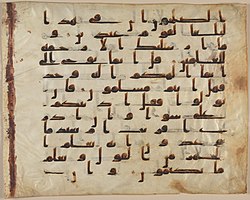Tradition vs scholarship
The copy of the Quran is traditionally considered to be one of a group commissioned by the third caliph Uthman. According to Islamic tradition, in 651, 19 years after the death of the Islamic Prophet, Muhammad, Uthman commissioned a committee to produce a standard copy of the text of the Quran (see Origin and development of the Quran). [5] According to one report, 6 certified copies were written of which 5 were dispatched to various parts of the Islamic world, with the sixth being for Uthman's personal use in Medina. Each copy dispatched was accompanied by a reciter. These include: Zayd ibn Thabit (sent to Madinah), Abdullah ibn al-Sa'ib (sent to Makkah), al-Mughirah ibn Shihab (sent to Syria), Amir ibn Abd Qays (sent to Basra) and Abdul Rahman al-Sulami (sent to Kufa). [6] The only other surviving copy was thought to be the one held in Topkapı Palace in Turkey, [5] [7] but studies have shown that the Topkapı manuscript is also not from the 7th century, but from much later. [8] [9]
Uthman was succeeded by Ali, who is thought to have taken the Uthmanic Quran to Kufa, now in Iraq. According to another, the Quran was brought from the ruler of Rum to Samarkand by Khoja Ahrar, a Turkestani sufi master, as a gift after he had cured the ruler. The Quran remained in the Khoja Ahrar Mosque of Samarkand for the next four centuries. [5]
Certified history
The mushaf was initially in Damascus, Syria. However, after Tamerlane sacked the city during the Siege of Damascus in the beginning of the 15th century, he took it to Samarkand, as loot. [5] In 1868, the Russians conquered Samarkand in the Siege of Samarkand and as a result Russian general Abramov bought it from the imams of the mosque [10] and it was sent to the Imperial Library in Saint Petersburg (now the Russian National Library). [5]
It attracted the attention of Orientalists and eventually S. Pissaref published a facsimile edition in 1905. [11] Unfortunately, before doing so he decided to retrace the fresh ink in the folios whose ink had faded over time. In doing so, he introduced many unintentional alterations into the text. [12] This rendered the text corrupted and hence useless for the purpose of textual study.
After the October Revolution, Lenin, in an act of goodwill to the Muslims of Russia, gave the Quran to the people of Ufa in Bashkortostan. After repeated appeals by the people of the Turkestan ASSR, the Quran was returned to Central Asia, to Tashkent, in 1924, where it has since remained. [5]


